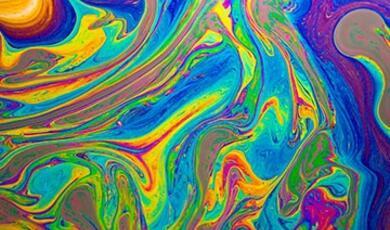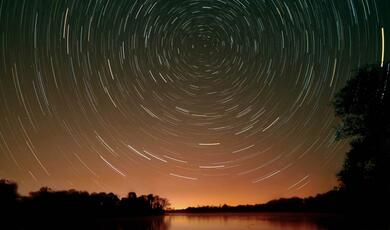The Planets
Share
- Details
- Text
- Audio
- Downloads
- Extra Reading
Dava Sobel talked about her latest book 'The Planets' in which she tells the human story of the nine planets of our solar system. This groundbreaking new work traces the lives of each member of our solar family, from myth and history, astrology and science fiction, to the latest data from the modern era's robotic space probes. Whether revealing what hides behind Venus's cocoon of acid clouds, describing Neputune's beauty, or capturing the excitement at the Jet Propulsion Laboratory when the first pictures from Cassini at Saturn were recently beamed to earth, Dava Sobel's tour of the solar system is filled with science, history, biography and storytelling.
Dava Sobel is the author of 'Longitude', a prize-winning international bestseller, and 'Galileo's Daughter', which was shortlisted for the Pulitzer Prize.
Download Text
The Planets
Dava Sobel
This is a very exciting week in planetary sciences because the entire world’s community of planetary scientists is converged on Cambridge. They’re all there discussing the latest findings from the Cassini spacecraft, and planets beyond Pluto, and matters like that. I’m very happy to be in England at this time.
We live in a great era for planets, new ones being found all the time, and this book was occasioned partly by the discovery of planets of other stars, making the planets of our solar system even more important and significant than they were before, and also by a question my agent put to me once, which was, “What is the difference between the solar system and the galaxy, and the galaxy and the universe?” It was a question that made me realise that one could be extremely intelligent, very well educated, and highly successful in professional life, and not have any idea of what was up in the night sky. People like that really want to know, but they don’t have a ready road into the subject. He asked if I could write something that would speak to him, at his level, and tell him about these things he didn’t know.
So the book was really addressed to him, because it’s very hard to write to “the general public”, whoever that is; much better to have an individual in mind, someone you know and could really talk to, and that made the job a little easier. It was of course not an easy job because, unlike the other books I’ve written, this one has no continuous story and no hero. Most of the planets have been known since ancient times, and then the rest have been discovered over a period of centuries, and certainly not all by the same person. So it was difficult to figure out what to do with the material, but the planets turn up all over our popular culture; we trip over them everywhere. Even the names of the days of the week are named for the planets. They show up in mythology, science fiction, astrology, many, many places, and so I made a list of all those themes, and then I realised there were as many themes as there were planets, and it became apparent that each theme had a particular reason for being tied to a certain planet, and that was how the book took shape.
To start off, I’d like to read you the first chapter. It’s only about fifteen minutes. I think it is before dinner, so probably everyone can stay awake! Then I’d like to show you some images that an artist friend of mine concocted to portray the relationships between the planets and these themes that I’ve used in the book to introduce them.
“My planet fetish began, as best I can recall, in third grade, at age 8, right around the time I learned that Earth had siblings in Space, just as I had older brothers in high school and college. The presence of the neighbouring worlds was a revelation, at once specific and mysterious, in 1955, for although each planet bore a name and held a place in the Sun’s family, very little was known about any of them. Pluto and Mercury, like Paris and Moscow, only better, beckoned a childish imagination to ultra-exotic utopias.
The few sure facts about the planets suggested fantastic aberrations, ranging from unbearable extremes of temperature to the warping of time. Since Mercury, for example, could circle the Sun in only 88 days, compared to Earth’s 365, then a year on Mercury would whiz by in barely three months, much the way dog years packed seven years of animal experience into the dog owner’s one and thereby accounted for the regrettably short lives of pets.
Every planet opened its own realm of possibility, its own version of reality. Venus purportedly hid lush swamps under its perpetual cloud cover, where oceans of oil or possibly soda water bathed rain forests filled with yellow and orange plant life – and these opinions issued from serious scientists, not comic books or sensational fiction.
The limitless strangeness of the planets contrasted sharply with their small census; in fact, their nineness helped define them as a group. Ordinary entities came in pairs or dozens or quantities ending in a five or a zero, but planets numbered nine and nine only. Nine, odd as outer space itself, could nevertheless be counted on the fingers, compared to the chore of memorising 48 state capitals or significant dates in the history of New York City. The planets promised mastery in an evening. Any child who committed the planets’ names to memory, with the help of an appealing nonsense sentence pneumonic, “My Very Educated Mother Just Served Us Nine Pies”, simultaneously gained their proper progression outward from the Sun – Mercury, Venus, Earth, Mars, Jupiter, Saturn, Uranus, Neptune, Pluto.
The manageable sum of planets made them seem collectable, and motivated me to arrange a shoe box diorama for the science fair. I gathered marbles, jack’s balls, ping-pong balls, and the pink rubber Spaldings we girls bounced for hours on the sidewalk, and I painted them tempura and hung them on pipe cleaners and string. My model, more like a doll’s house than a scientific demonstration, failed to give any real sense of the planets’ relative sizes or the enormous distances between them. By rights, I should have used a basketball for Jupiter to show how it dwarfed all the others, and I should have mounted everything in a giant carton from a washing machine or a refrigerator the better to approximate the solar system’s grandiose dimensions.
Fortunately, my crude diorama, produced with a complete lack of artistic skill, did not kill my beautiful visions of Saturn suspended in the perfect symmetry of its spinning rings, or the mutating patterns on the Martian landscape, which were attributed in scientific reports of the 1950s to seasonal cycles of vegetation.
After the science fair, my class staged a planets play. I got the part of Lonely Star, because the script called for that character to wear a red cape and I had one left over from a Halloween costume. As Lonely Star, I soliloquised the Sun’s wish for companionship, which the planet actors granted by joining up with me, each in a speech admitting his own peculiarities. The play’s most memorable performances were delivered by Saturn, who twirled two hula-hoops while reciting her lines, and the Earth, plump and self-conscious, yet forced to announce matter-of-factly, “I am 24,000 miles around my middle”! Thus was the statistic of the Earth’s circumference indelibly impressed upon me.
Note that we always said “the Earth” in those days. “The Earth” did not become “Earth” until after I came of age, and the Moon changed from a nightlight to a destination. My role as Lonely Star helped me appreciate the Sun’s relationship to the planets as parent and guide. Not for nothing is our part of the universe called the Solar System, in which each planet’s individual makeup and traits are shaped in large measure by proximity to the Sun. I had omitted the Sun from my diorama because I hadn’t understood its power, and besides it would have posed an impossible problem of scale.
In his ingenious pamphlet “The Thousand Yard Model”, where the Earth is a peppercorn, Guy Ottowell guides the construction of a scale model solar system using a bowling ball for the Sun. The 8,000 mile wide Earth, here reduced to a peppercorn, takes its rightful place, 78 feet from the bowling ball.
Another reason for leaving out the Sun, and likewise the Moon, was the bright familiarity of both objects, which seemed to render them regular components of Earth’s atmosphere, whereas the planets were glimpsed only occasionally, either before bedtime or in a still, dark, early morning sky, and therefore more highly prized.
In our class trip to the Haydn Planetarium, we city kids saw an idealised night sky, liberated from the glare of traffic signals and neon lights. We watched the planets chase each other around the heavens of the dome. We tested the relative strength of gravity with trick scales that told how much we’d weigh on Jupiter – 400 pounds and more for a normal sized teacher – or Mars, featherweights all, and we gawked at the sight of the fifteen ton meteorite that had fallen from out of the blue over Oregon’s Willamette Valley, posing a threat to human safety that few of us had thought to fear. The Willamette Meteorite, still on permanent display at what is now the Rose Center for Earth and Space, was said to be, incredibly, the iron nickel core of an ancient planet once in orbit around the Sun. That world had shattered somehow several billion years back, setting its fragments adrift in space. Chance had nudged this particular piece toward the Earth, where it hurtled down to the Oregon ground at tremendous speed, burning up from the heat of friction, and hitting the Valley floor with the impact of an atom bomb. Later, as the meteorite lay still over eons, the acidic rains of the Pacific Northwest chewed large holes in its charred and rusted hulk. Here was a primal scene to upset my innocent planet ideas. This dark, evil invader had no doubt consorted in space with hordes of other stray rocks and metal chunks that might strike Earth at any moment. My solar system home, till that moment a paragon of clockwork regularity, had turned into a disorderly, dangerous place.
The launch of Sputnik in 1957 when I was ten scared me to death. As a demonstration of foreign military strength, it gave new meaning to the school-wide air raid drills, in which we crouched under our desks for pretended safety, our backs to the windows. Clearly, we still had more to dread from angry fellow humans than from wayward space rocks.
All through my teens and twenties, as the country realised the young President’s dream of a rocket to the Moon, clandestine rockets in missile silos kept collective nightmares alive, but by the time the Apollo astronauts brought back their last batch of moon rocks in December 1972, peaceful, hopeful spaceships had landed also on Venus and Mars, and another, the US Pioneer 10, was en route to a Jupiter fly-by. Throughout the 1970s and 1980s, hardly a year passed without an unmanned excursion to another planet. Images radioed home to Earth by robot explorers painted detail upon detail on the planets’ long blank faces. Whole new entities came to light too, as spacecraft encountered literally dozens of new moons at Jupiter, Saturn, Uranus and Neptune, as well as multiple rings around all four of those planets. Even though Pluto remained unexplored, deemed too distant and too difficult to visit, its own unexpected moon was discovered accidentally in 1978 through careful analysis of photographs taken by ground-based telescopes.
Had my daughter, born in 1981, attempted her own diorama of the revised and expanded solar system when she turned eight, she would have needed handfuls of jelly beans and jaw-breakers to model the many recent additions. My son, three years her junior, might have opted to model his on our home computer.
Despite the increased population of the solar system, its planets stayed stable at nine, at least until 1992. That year, a small, dark body, independent of Pluto, was detected on the solar system’s periphery. Similar discoveries soon followed, until the total number of diminutive out-lighters grew to 700 over the ensuing decade. The abundance of mini-worlds made some astronomers wonder whether Pluto should continue to be regarded as a planet or re-classified as the largest of the trans-Neptunian objects. The Rose Center has already excluded Pluto from the planetary roll-call.
In 1995, only three years after the first of Pluto’s numerous neighbours was found, something even more remarkable came to light. It was a bona fide new planet of another star. Astronomers had long suspected that stars other than the Sun might have their own planetary systems, and now the first one had surfaced, at 51 Pegasi in the constellation of the Flying Horse. Within months, other exo-planets, as the newly discovered extra-solar planets were quickly dubbed, turned up at stars such as Upsilon Andromedae, 70 Virginus B and PSR 1257 plus 12. At least 160 additional exo-planets have since been identified, and refinements in discovery techniques promise to uncover many more in the near future. Indeed, the number of planets in our Milky Way Galaxy alone may far exceed its complement of 100 billion stars. My old, familiar solar system, once considered unique, now stands as merely the first known example of a popular genre.
As yet, no exo-planets have been imaged directly through a telescope, so their discoverers are left to imagine what they look like. Only their sizes and orbital dynamics are known. Most of them rival giant Jupiter in heft because large planets are easier to find than small ones. Indeed, the existence of exo-planets is deduced from their effect on their parent star. Either the star wobbles as it yields to the gravitational attraction of unseen companions, or it periodically dims as its planets pass in front and impede its light. Small exo-planets, the size of Mercury or Mars, must also orbit distant suns, but being too tiny to perturb a star, they elude detection from afar. Already, planetary scientists have appropriated the name Jupiter as a generic term, so that a Jupiter means a large exo-planet and the mass of an extremely large exo-planet may be quantified as three Jupiters or four.
In the same fashion, an Earth has come to represent the most difficult, most desirable goal of today’s planet hunters, who are devising ways to probe the galaxy for petite, fragile spheres in the favourite shades of blue and green that hint at water and life. Whatever daily concerns dominate our minds at the dawn of the present century, the ongoing discovery of extra-solar planetary systems defines our moment in history, and our own solar system, rather than shrink in importance, is one among many, proves the template for comprehending a plethora of other worlds. Even as the planets reveal themselves to scientific investigation and repeat themselves across the universe, they retain the emotional weight of their long influence on our lives and all that they have ever signified in Earth’s skies – gods of old, and demons too, they were once, they still are, the sources of an inspiring light, the wanderers of night, the far horizon of the landscape of home.”
So that gives you the flavour of the thing, and now I want to show you some pretty pictures.
All these images were painted by a space artist named Lynette Cook, and if you’re interested in them, you can look at her website, which is justwww.lynettecook.com. This picture is actually on the hardcover of The Planets. If you peel off the paper dust-jacket, this is what you will see, and these are all her paintings of the planets. This is her rendition of my diorama. I’m sure many of you actually made something like this at some point? It was a popular pastime. Of course mine didn’t look nearly that good, but now I think I’ve replaced my own memory of mine with this one. She’s tied together many things here, because if we look out the window of this child’s room of course, we are not on the Earth, we are on some other world that has a very different sort of view out the window. Just a way of thinking about what other worlds there are…
For the Sun, I chose the Book of Genesis, and the language of it too, because the solar system and the universe as a whole came to light as something out of nothing, much the way things begin in Genesis, with the declaration of light. So she’s created a little solar system Garden of Eden, if you will, and in the topiary bush, we have the planets taking shape, forming in a disc around the young Sun, and the Sun itself is represented as the face of a sundial, so you can see actual sunspots on the surface of it. In the sky are the phases of partial eclipse, leading up to totality where the Sun’s magnificent corona, which is usually invisible, suddenly bursts into view, and at those times, if you’re lucky enough to chase an eclipse, you’ll also see beautiful red hydrogen prominences.
Her technique is an interesting combination of painting, drawing, collage and photography, so that the leaves on the tree are real leaves.
Mercury is the mythology planet because there are more mentions of the god Mercury in the Greco-Roman myths than of any other god. He was extremely busy, rushing here and there, conducting the souls of the dead down to their final resting place, delivering messages for the gods. So we’ve placed him on a Grecian urn, and in the sky, the body that looks a little bit like a full moon is actually the planet Mercury. The vase is standing between the worlds of the living and the dead, because Mercury is really visible only at twilight, whether it’s morning twilight or evening twilight, so that is his brief time, because it’s so close to the Sun. Mercury stole the cattle herds from Apollo on the first day of his life, and he fashioned the lyre and so invented music.
Venus is the planet of beauty, which I was able to represent in the book via poetry, but artistically, we relied on traditional symbols of beauty, the Venus de Milo and rose. Venus is so female in the Western imagination that when the Magellan spacecraft actually discovered what was on the surface, the International Astronomical Union decreed that every single feature had to have a female name. So all of the craters and land masses are called after huntresses and love goddesses and real women in history.
There is a depiction of the way Venus changes in its appearance as it approaches and recedes from us. So when we see it super-bright in the evening sky, it’s close to us, but it’s actually in a crescent phase, and if you looked at it through a telescope, you would see that it’s not full. It’s most lovely when we see it with the young Moon, although I haven’t seen the horizon since I’ve been in England, so I’m not really sure what’s transpiring there. It’s only in the Central and South American Indian cultures that Venus was seen as male, which is why some of that imagery is depicted. The pull on the window shade is the actual planet Venus as it looks, veiled in its hostile clouds of sulphuric acid and other nasty compounds, and the spacecraft is the Magellan spacecraft that revealed what the surface really looks like.
The Earth has required many voyages of exploration to learn its true extent. What was called the known world a couple of thousand years ago was a very small place. Nobody really knew what was on the other side. So I chose to trace various voyages of exploration, and along the way, not only were the other continents discovered, but the fact that the Earth is a planet became known, and the Earth had to take its rightful place in orbit around the Sun instead of being the centre of the universe. There’s a voyage inward too, to learn what’s under the surface, what lies in the middle of the Earth. This particular image was drawn before the awful tsunami of last December, but the plate boundaries were the ones that take responsibility for those catastrophes.
The Moon is responsible for lunacy, and I got to tell a true story in this chapter about a friend of mine who was actually given a sample of Moon dust. She had a boyfriend who was working in a laboratory analysing the Moon rocks, and he gave her some of the dust. When I asked to see it, she told me that she had eaten it. This is a true story. So this gives you the feeling of the Moon dust touching us here on Earth, and the top of the gazebo has an outline of the Apollo lunar module, and the various phases of the Moon drawn around it. Then at the bottom is a real Moon garden. A Moon garden can contain all white flowers, or all flowers that bloom in the dark, or a little of each. There are angel’s trumpets. They are night blooming. Perched on the angel’s trumpet is a luna moth. You can see how much fun we had building these images.
Mars is a science-fiction world. There’s been more science-fiction written about the planet Mars than about any other planet. I had not been a big science-fiction buff, but this book gave me the excuse, the need, to read things such as Dune, and the Martian Chronicles and the novels of Edgar Rice-Burrows, and it was great fun – oh, and War of the Worlds, which is a truly wonderful book. Obviously, we have some sort of hostile invasion in progress, and a natural bombardment of the Martian surface has lofted all sorts of material into space. These things happen all the time. The planets exchange material, and this material is drifting towards the Earth in the distance. Rocks from Mars have actually landed on Earth. In 1996, there was lots of excitement about a particular rock that seemed to show evidence that something had lived inside it while it was on the Martian surface, fuelling our belief that there was or is or will be life on Mars.
There is an image of Mars that Percival Lowell made popular, a world criss-crossed by canals built by a dying of thirst, a civilisation dying of thirst, and trying to husband its water resources with canals.
Another image is of the Mars a lot of us are being introduced to today, a world that was very wet at one time in its history, and that still probably has water, although the water has frozen and much of it has probably gone underground.
There is the infamous rock, which looks as though it’s crawling with maggots to give the feeling of live things living there, residing there.
In Jupiter, I took a big risk because talking about astrology if you’re a science writer is a very dangerous thing to do. By all rights, you’re supposed to make a disgusted face and say that it’s all very ridiculous and has no relation to real astronomy. But lots of people know the planets through astrology, and it seemed silly to dismiss all of that and insult them. I decided to look at it realistically. I even had my chart done. I consulting an astrologer and had my chart done, and was immediately sorry I had done it because she showed me how I had been on a cycle of great creativity over a period of about 30 years and this cycle was now coming to an end! It’s very tough to start writing a book when someone has just told you that your creative period is over, but I soldiered on, and I reminded myself fortunately that I don’t really believe in astrology, so that got me through some tough places.
Oneoutline represents the Galileo spacecraft. Of course many astronomers in history did cast horoscopes, and Galileo was one of them. There are records from his lifetime of his own horoscope, which he probably cast himself. He cast them for all of his children too, and also for the Grand Dukes of Tuscany.
So I had the astrologer interpret Galileo’s chart, and then I asked her to create a chart for the spacecraft. You can do that; you can draw a natal chart for a spacecraft. These are the clouds of Jupiter, which do have lightning in them. You see a comet coming in. Lots of comets are diverted by the gravitational attraction of Jupiter and can be broken up or pulled in to Jupiter.
One image is a real chart, using the face of Jupiter as the backdrop, with symbols expressing the relationships among the planets at the moment of the spacecraft’s launching, which you could call its birth. Most of it lines up to look like a really important object with lots of respect. The only thing that’s really bad is that the planet of communication creates a square, terrible, bad angle with the planet Jupiter. I found this really amazing because this poor spacecraft was plagued by communications problems its entire life. I didn’t know quite what to make of that, that it showed up in the chart…just one of those strange coincidences.
There is a larger chart showing the symbols for all the zodiac constellations and the four moons of Jupiter. One of the things the Galileo spacecraft discovered was a gigantic salty ocean on the moon Europa, and that made NASA decide to destroy the spacecraft while they could still give it commands and tell it what to do, because if they lost control of it, what if one day it just stumbled into Europa and destroyed that pristine environment or actually killed some life form coming to be in that ocean? So they decided they would just point it at Jupiter, where they were sure nothing could be living, and have it meet its end.
You’ve all heard about the music of the spheres: this is an ancient idea that somehow the spaces between the planets should follow the same rules that govern the steps on a musical scale, that there is music in the heavens and that it’s all connected. Here in England, I’m sure everybody knows of the music of Gustav Holst, who of course wrote the Suite for the Planets. The music that’s the wallpaper in this image is actually part of the score, and it is the Saturn movement, which was his acknowledged favourite of the whole Suite.
The topic of music relates extremely well to Saturn. Kepler picked up this idea of the music of the spheres, and actually wrote little snatches of melodies based on his mathematical calculations of the orbits of the planets. So that’s what Saturn would sing if you could have God’s perspective and hear the real music of the spheres.
There is a picture of the Huygens probe of the Cassini spacecraft descending into the clouds of Saturn’s largest moon, Titan, which actually happened last year. The rings of Saturn take their shape from sculpting by gravitational forces among the particles in the rings and the moons that orbit outside them, and those kinds of resonances also have their counterparts in music.
There is a tile floor under the lute. The white elements, those show the Cassini spacecraft with its antenna, and then the elements between are the Huygens’ probe descending, as you would see it if you were standing on the surface of Titan when it was coming down.
The chapter on Uranus and Neptune is all about discovery. I wrote this chapter really about the Herschel family. William Herschel was the first person to discover a planet, and his sister was also a remarkable character. They were both amateur astronomers. Herschel built his own telescopes, and they were better than any telescopes in the world. After he’d discovered the planet, the directors of observatories everywhere came to him to buy telescopes. So there is a salute to Herschel’s telescope in the foreground. It occurred to me to write this chapter as a long letter from Caroline Herschel to the only other woman in the world at that time who had also discovered a comet, and that was the young American Mariah Mitchell.
Just before coming over here, I read a review of my book that said that all of the material was original except for a verbatim reprinting of a letter that Caroline Herschel had written to Mariah Mitchell in the 1800s. So I just want to tell you now, it isn’t really a verbatim reprinting of a letter.
When the planet was discovered, of course no one was expecting another planet. It was thought that there could not be any more than the ones there were. So Herschel at first thought it was a comet, and the image of the comet in the cracked picture frame is a way to say that that idea fell by the way.
In one picture frame, we have Uranus the way it appeared to the Voyager spacecraft, as a very dull, blue blob. Nobody could tell what was going on there. But now, thanks to improved ground-based telescope technology and images from the Hubble telescope, Uranus has lots of detail, and the weather is changing. The seasons there take about 20 years to transpire, so summer’s coming on, and things are really heating up and looking a lot more interesting. The two images to the right are both of Neptune, which has always been the more picturesque of the two.
The theme for Pluto was UFO, because Pluto itself is a UFO. What is it really? Is it a planet/isn’t it a planet? It’s a big topic of debate now. It brought to mind thoughts of my grandparents, who came to the United States as immigrants from Russia and Poland, and they had to enter the country through the Ellis Island Immigration Centre.
Bear with me here – I think in the book it makes more sense than I’m making it make right now, but the idea of worlds beyond the known planets being allowed in to the solar system, there really is a parallel there. In one image, we have the actual Pluto and its moon, Sharon. Of course nobody’s gotten anything like decent images of them. When you look at pictures, they really look like those faked photos of UFOs, so we don’t have a clear idea yet of what they look like, but finally, there is a spacecraft that I think will make it to Pluto, so we’ll know more.
The reddish world is an ideal picture of Sedna, one of the newer bodies that belongs to our solar system, and the bluish-green one is something people are hoping to find. Maybe, maybe somewhere, there’s something like that waiting. All the little worlds on the bottom are other things that might swim into view. You may be wondering what the cat is doing there. Clyde Tombaugh, who discovered the planet Pluto in 1930, had a cat and it looked just like that. There are pictures of his cat, and his cat’s name was Pluto. The shape of the window, through which the water and the light and the knowledge of other worlds is pouring in, that is the shape of the Lowell telescope at the observatory on Mars Hill where Pluto was discovered.
This is a surreal image of course, not that the others were realistic, but this one just shows the planets in the most familiar guise we could give them, actually growing on trees, or growing on ground cover, to depict the idea that they really are everywhere, you trip over them in daily life, and that I hope they will feel like more familiar places to you, either as a result of this talk or reading this book or of things that you follow in the news.
© Dava Sobel, Gresham College, 7 September 2005
This event was on Wed, 07 Sep 2005
Support Gresham
Gresham College has offered an outstanding education to the public free of charge for over 400 years. Today, Gresham College plays an important role in fostering a love of learning and a greater understanding of ourselves and the world around us. Your donation will help to widen our reach and to broaden our audience, allowing more people to benefit from a high-quality education from some of the brightest minds.


 Login
Login






